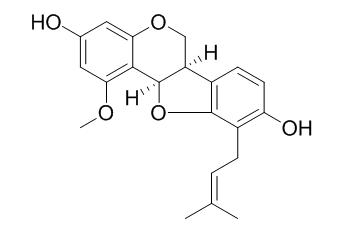1-Methoxyphaseollidin
1-Methoxyphaseollidin exhibits anti-Helicobacter pylori activity against the CLAR and AMOX-resistant strain as well as four CLAR (AMOX)-sensitive strains. 1-Methoxyphaseollidin may show moderate cytotoxic activity against KB and L1210 cells. 1-Methoxyphaseollidin also shows inhibition of lysoPAF acetyltransferase activity.
Inquire / Order:
manager@chemfaces.com
Technical Inquiries:
service@chemfaces.com
Tel:
+86-27-84237783
Fax:
+86-27-84254680
Address:
1 Building, No. 83, CheCheng Rd., Wuhan Economic and Technological Development Zone, Wuhan, Hubei 430056, PRC
Providing storage is as stated on the product vial and the vial is kept tightly sealed, the product can be stored for up to
24 months(2-8C).
Wherever possible, you should prepare and use solutions on the same day. However, if you need to make up stock solutions in advance, we recommend that you store the solution as aliquots in tightly sealed vials at -20C. Generally, these will be useable for up to two weeks. Before use, and prior to opening the vial we recommend that you allow your product to equilibrate to room temperature for at least 1 hour.
Need more advice on solubility, usage and handling? Please email to: service@chemfaces.com
The packaging of the product may have turned upside down during transportation, resulting in the natural compounds adhering to the neck or cap of the vial. take the vial out of its packaging and gently shake to let the compounds fall to the bottom of the vial. for liquid products, centrifuge at 200-500 RPM to gather the liquid at the bottom of the vial. try to avoid loss or contamination during handling.
Foods. 2022, 11(23):3905.
Asian Journal of Chemistry2018, 30(12):2699-2703
Drug Dev Res.2020, doi: 10.1002
Molecules.2019, 24(2):329
Chemistry of Plant Materials.2019, 215-222
VNU Journal of Science2023, 39(2):24-33.
New Zealand J. Forestry Sci.2014, 44:17
Korean Herb. Med. Inf.2021, 9(2):231-239.
Biomed Pharmacother.2019, 111:262-269
J Anal Toxicol.2021, bkab015.
Related and Featured Products
Life Sci. 2002 Aug 9;71(12):1449-63.
Anti-Helicobacter pylori flavonoids from licorice extract.[Pubmed:
12127165]
Licorice is the most used crude drug in Kampo medicines (traditional Chinese medicines modified in Japan).
METHODS AND RESULTS:
The extract of the medicinal plant is also used as the basis of anti-ulcer medicines for treatment of peptic ulcer. Among the chemical constituents of the plant, glabridin and glabrene (components of Glycyrrhiza glabra), licochalcone A (G. inflata), licoricidin and licoisoflavone B (G. uralensis) exhibited inhibitory activity against the growth of Helicobacter pylori in vitro. These flavonoids also showed anti-H. pylori activity against a clarithromycin (CLAR) and amoxicillin (AMOX)-resistant strain. We also investigated the methanol extract of G. uralensis. From the extract, three new isoflavonoids (3-arylcoumarin, pterocarpan, and isoflavan) with a pyran ring, gancaonols A[bond]C, were isolated together with 15 known flavonoids. Among these compounds, vestitol, licoricone, 1-Methoxyphaseollidin and gancaonol C exhibited anti-H. pylori activity against the CLAR and AMOX-resistant strain as well as four CLAR (AMOX)-sensitive strains. Glycyrin, formononetin, isolicoflavonol, glyasperin D, 6,8-diprenylorobol, gancaonin I, dihydrolicoisoflavone A, and gancaonol B possessed weaker anti-H. pylori activity.
CONCLUSIONS:
These compounds may be useful chemopreventive agents for peptic ulcer or gastric cancer in H. pylori-infected individuals.
Biol Pharm Bull. 1999 Oct;22(10):1144-6.
Inhibition of lysoPAF acetyltransferase activity by components of licorice root.[Pubmed:
10549875]
METHODS AND RESULTS:
Licorice root traditionally used as an anti-inflammatory drug exhibited an inhibitory effect on lysoPAF (platelet-activating factor) acetyltransferase in vitro: the ether soluble fraction of the crude drug produced a 27.3% inhibition at a concentration 10 microg/ml. From this fraction, licoricidin (1), 1-methoxyphaseollin (2), 6,8-diprenylgenistein (3) and 1-Methoxyphaseollidin (4) were isolated as active components, whose IC50 values were 7.7, 57, 19 and 48 microM, respectively.
CONCLUSIONS:
Licoricidin (1) seems to be one of the most potent compounds of plant origin isolated so far.
Chemical & Pharmaceutical Bulletin, 1998, 46(10):1511-1517.
Chemical Studies of Chinese Licorice-Roots. II. Five New Flavonoid Constituents from the Roots of Glycyrrhiza aspera PALL. Collected in Xinjiang.[Reference:
WebLink]
METHODS AND RESULTS:
From the air-dried roots of Glycyrrhiza aspera PALL. (Leguminosae) collected in Xinjiang province, China (known as a kind of "Shinkyo-Kanzo"), five new flavonoid compounds named glucoisoliquiritin apioside (1) (a chalcone bisdesmosidic triglycoside), 7-O-apioglucosyl-7,4'-dihydroxyflavone (5) (a flavone diglycoside), dehydroglyasperin C (7) (a prenylated isoflav-3-ene derivative), asperopterocarpin (9) and 1-Methoxyphaseollidin (12) (an O-prenylpterocarpan and a C-prenylpterocarpan, respectively), were isolated together with four known saponins, one known flavonoid O-glycoside, two known flavonoid C-glycosides, and seven flavonoids.
CONCLUSIONS:
The structures of the new compounds have been elucidated on the basis of their chemical and physicochemical properties. Some pterocarpan compounds showed moderate cytotoxic activity against KB and L1210 cells.



